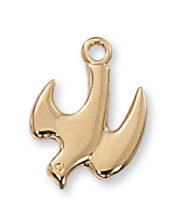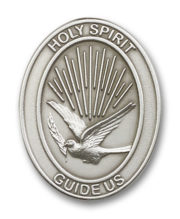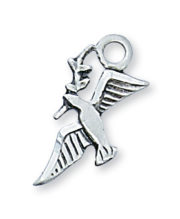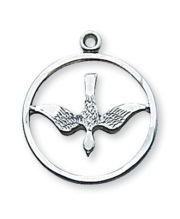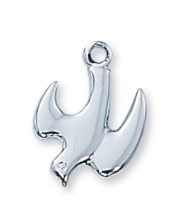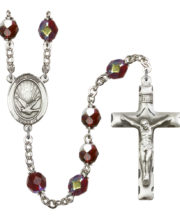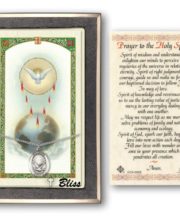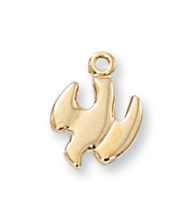Religious Education
What is the Holy Spirit?
What is the Holy Spirit?
In the Catholic Church, the Holy Spirit is the third person of the Holy Trinity, along with the Father and the Son. The Holy Spirit is considered to be the source of inspiration, guidance, and strength for Catholics, and is often invoked in prayer, worship, and sacraments.
The Holy Spirit is seen as the source of all spiritual gifts and graces, such as wisdom, understanding, counsel, fortitude, knowledge, piety and fear of the Lord. Catholics believe that the Holy Spirit is present in the Church, guiding and directing its members, and helping them to live out their faith.
The Holy Spirit is also believed to be the source of the seven gifts: wisdom, understanding, counsel, fortitude, knowledge, piety and fear of the Lord. These gifts are given to Catholics as they are Confirmed in the Church.
The Holy Spirit is also believed to be the source of the twelve fruits: charity, joy, peace, patience, kindness, goodness, generosity, gentleness, faithfulness, modesty, self-control, and chastity. These fruits are the result of the gifts of the Holy Spirit working in the life of the believer.
One of the most famous references to the Holy Spirit in the Catholic Church is the event of Pentecost, which is commemorated on the 50th day after Easter.
What does the Holy Spirit look like?
 In the Catholic Church, the Holy Spirit is not depicted as having a physical appearance or form. The Holy Spirit is considered to be a divine, spiritual being, not a physical entity. Therefore, the Holy Spirit is not usually depicted in art or iconography in the same way that Jesus and the Virgin Mary are.
In the Catholic Church, the Holy Spirit is not depicted as having a physical appearance or form. The Holy Spirit is considered to be a divine, spiritual being, not a physical entity. Therefore, the Holy Spirit is not usually depicted in art or iconography in the same way that Jesus and the Virgin Mary are.
The Holy Spirit is often represented symbolically in Catholic art and iconography, such as through the image of a dove. This symbol is derived from the Bible, specifically from the account of Jesus’ baptism in the Gospel of Matthew, where it is said that the Holy Spirit descended upon Jesus in the form of a dove.
Another symbol commonly used to represent the Holy Spirit in the Catholic Church is the image of tongues of fire. This symbol is derived from the account of the descent of the Holy Spirit upon the apostles at Pentecost, as described in the book of Acts, where it says that tongues of fire appeared over the apostles’ heads, indicating the presence of the Holy Spirit.
In summary, the Holy Spirit is not depicted as having a physical appearance or form in the Catholic Church. Instead, the Holy Spirit is represented symbolically through images such as a dove or tongues of fire. These symbols are used to remind Catholics of the presence and power of the Holy Spirit in their lives and in the Church.
Why is the Holy Spirit portrayed as a dove and flames?
The Holy Spirit is often portrayed as a dove in Christian art and iconography because of the account in the Bible of the Holy Spirit descending upon Jesus in the form of a dove at his baptism. In the Gospel of Matthew, it is written that “and a voice came from heaven, ‘You are my Son, the Beloved; with you I am well pleased.” (3:17) and then “and behold, a voice from heaven said, ‘This is my Son, the Beloved, with whom I am well pleased.'” (3:17) It is also said that “And when Jesus was baptized, he went up immediately from the water, and behold, the heavens were opened and he saw the Spirit of God descending like a dove and alighting on him” (Matthew 3:16).
The dove is often depicted as descending from the heavens, and it is seen as a symbol of the Holy Spirit’s purity, gentleness, and peace. It also represents the Holy Spirit’s role as a comforter, as the dove is a symbol of love and tenderness.
The Holy Spirit is also often portrayed as flames in Christian art and iconography, based on the account of the descent of the Holy Spirit upon the apostles at Pentecost, as described in the book of Acts, where it says that “tongues of fire” appeared over the apostles’ heads, indicating the presence of the Holy Spirit. This symbol is associated with the Holy Spirit’s power and transformative nature. The flames are also a reminder of the Spirit’s role in the sacraments of initiation, especially in Confirmation.
In summary, the Holy Spirit is often portrayed as a dove in Christian art and iconography because of the account of the Holy Spirit descending upon Jesus in the form of a dove at his baptism. The Holy Spirit is also portrayed as flames to commemorate the descent of the Holy Spirit upon the apostles at Pentecost, as described in the book of Acts. The flames are a symbol of the Holy Spirit’s power, transformative nature and its role in the sacraments of initiation. This symbolism helps to convey the idea of the Spirit as a powerful, transformative force, which works to renew and sanctify the Church and its members.
What is Pentecost?
 Pentecost is a Christian feast that commemorates the descent of the Holy Spirit upon the apostles and other followers of Jesus Christ, as recorded in the New Testament. It is celebrated on the 50th day after Easter Sunday and it marks the end of the Easter season.
Pentecost is a Christian feast that commemorates the descent of the Holy Spirit upon the apostles and other followers of Jesus Christ, as recorded in the New Testament. It is celebrated on the 50th day after Easter Sunday and it marks the end of the Easter season.
The feast of Pentecost is based on the account of the descent of the Holy Spirit upon the apostles as recorded in the book of Acts, chapter 2. According to the Bible, the apostles were gathered in Jerusalem on the day of Pentecost, when a sound like a strong wind descended upon them, and they were filled with the Holy Spirit. The apostles then began to speak in tongues, and many people who were present in Jerusalem from different nations, heard them speaking in their native languages. This was considered a sign of the power of the Holy Spirit.
Pentecost is considered to be the birthday of the Church, as it is believed that the Holy Spirit descended upon the apostles, giving them the power and ability to spread the message of Jesus Christ to the world. The feast is celebrated by Catholics and many other Christian denominations.
In the Catholic Church, the feast of Pentecost is celebrated with special liturgies and rituals, such as the use of red vestments and the reading of the story of Pentecost from the book of Acts. It is also a day when the sacrament of Confirmation is administered to those who have completed their formation in the RCIA (Rite of Christian Initiation of Adults) process.
In summary, Pentecost is a Christian feast that commemorates the descent of the Holy Spirit upon the apostles and other followers of Jesus Christ, as recorded in the New Testament. It is celebrated on the 50th day after Easter Sunday and it is considered the birthday of the Church. It is celebrated with special liturgies and rituals in the Catholic Church.
Why is the Holy Spirit a part of the Trinity?
The Trinity is a central doctrine in Christianity, which teaches that there is one God who exists in three distinct persons: the Father, the Son, and the Holy Spirit. These three persons are co-equal and co-eternal, and they are each fully God, yet they are one God.
The concept of the Trinity is rooted in the Bible, particularly in passages such as the Great Commission in Matthew 28:19, where Jesus commands his followers to baptize “in the name of the Father, and of the Son, and of the Holy Spirit.”
The Holy Spirit is considered to be a part of the Trinity because it is believed that the Holy Spirit is fully God, co-equal with the Father and the Son. The Holy Spirit is considered to be the third person of the Trinity, and is seen as the source of inspiration, guidance, and strength for Catholics, and is often invoked in prayer, worship, and sacraments.
The Holy Spirit is believed to be involved in the creation of the world, the revelation of God to humanity, the inspiration of scripture, the sanctification of the believer, and the guidance of the Church. It is also believed that the Holy Spirit is the “Lord and giver of life” and the “soul” of the Church.
In summary, the Trinity is a central doctrine in Christianity that teaches that there is one God who exists in three distinct persons: the Father, the Son, and the Holy Spirit. The Holy Spirit is considered to be a part of the Trinity because it is believed that the Holy Spirit is fully God, co-equal with the Father and the Son, and the source of inspiration, guidance, and strength for Catholics, and is often invoked in prayer, worship, and sacraments.
How is the Holy Spirit involved in the sacraments?
In the Catholic Church, the Holy Spirit is believed to be involved in the sacraments in a number of ways:
-
Baptism: The Holy Spirit is the “principal agent” in the sacrament of baptism, as it is believed that the Holy Spirit is the one who regenerates and sanctifies the soul of the person being baptized. The rite of baptism includes an anointing with the oil of chrism which signifies the gift of the Holy Spirit.
-
Confirmation: The Holy Spirit is also the “principal agent” in the sacrament of confirmation. It is believed that the Holy Spirit strengthens the person being confirmed in their faith, and gives them the gifts of wisdom, understanding, counsel, fortitude, knowledge, piety, and fear of the Lord.
-
Eucharist: The Holy Spirit is present in the sacrament of the Eucharist, as it is believed that the Holy Spirit transforms the bread and wine into the body and blood of Jesus Christ.
-
Holy Orders: The Holy Spirit plays a role in the sacrament of holy orders, as it is believed that the Holy Spirit calls certain individuals to the priesthood or the diaconate, and gives them the grace to fulfill their duties as ministers of the Church.
-
Anointing of the Sick: The Holy Spirit is also present in the sacrament of the Anointing of the Sick, as it is believed that the Holy Spirit brings comfort, healing, and peace to the sick person, and strengthens them in the face of illness and death.
In the Catholic Church, the Holy Spirit is believed to be the “principal agent” in the sacraments of baptism and confirmation, and is present in the sacraments of the Eucharist, holy orders, and the anointing of the sick.
What are the gifts and fruits of the Holy Spirit?
 In the Catholic Church, the gifts and fruits of the Holy Spirit are considered to be special graces or abilities given by the Holy Spirit to believers to help them live out their faith and grow in their relationship with God.
In the Catholic Church, the gifts and fruits of the Holy Spirit are considered to be special graces or abilities given by the Holy Spirit to believers to help them live out their faith and grow in their relationship with God.
The gifts of the Holy Spirit are:
- Wisdom: The ability to understand the mysteries of faith and the plan of God for our lives.
- Understanding: The ability to grasp the meaning and implications of what we believe.
- Counsel: The ability to guide others with knowledge and insight.
- Fortitude: The ability to stand up for what is right in the face of opposition.
- Knowledge: The ability to perceive the truth about God and his creation.
- Piety: The ability to love and serve God with reverence and devotion.
- Fear of the Lord: The ability to stand in awe and wonder of God’s greatness and holiness.
The fruits of the Holy Spirit are:
- Charity: Love for God and for others.
- Joy: A sense of happiness and contentment in God.
- Peace: A deep sense of inner calm and serenity.
- Patience: The ability to bear with others’ faults and difficulties.
- Kindness: A willingness to be helpful and supportive.
- Goodness: A desire to do what is right and just.
- Generosity: A willingness to share our time, talents, and resources with others.
- Gentleness: A kind and compassionate attitude towards others.
- Faithfulness: A steadfastness in our commitment to God and others.
- Modesty: A humble and unassuming manner.
- Self-control: The ability to control our impulses and passions.
- Chastity: Purity of mind and body.
These gifts and fruits are not only given to individuals at Confirmation but are also developed throughout a person’s life through the work of the Holy Spirit in them. The gifts of the Holy Spirit empower the believer to live a virtuous life and to witness to the Gospel, while the fruits of the Holy Spirit are the result of this encounter with the Spirit, they are the evidence of the presence of the Spirit in the believer’s life.
What is the meaning of “baptism in the Holy Spirit”?
In the Catholic Church, baptism in the Holy Spirit refers to the sacrament of Confirmation, which is typically received by Catholics as teenagers or young adults. The sacrament is administered by a bishop or priest, and involves the laying on of hands and the anointing of the person with chrism, a consecrated oil. The purpose of Confirmation is to strengthen the individual in their faith and to empower them to live as a witness to the Gospel. It is considered to be one of the three sacraments of initiation, along with baptism and Holy Communion.
What does the Catechism say about the Holy Spirit?
The Catechism of the Catholic Church is a comprehensive compendium of Catholic doctrine, and it contains a section on the Holy Spirit. According to the Catechism, the Holy Spirit is the third person of the Holy Trinity, along with the Father and the Son. The Holy Spirit is considered to be the source of inspiration, guidance, and strength for Catholics, and is often invoked in prayer, worship, and sacraments.
The Catechism states that the Holy Spirit is the “Lord and giver of life” (CCC 687), and that the Spirit is “the personal subject of interior sanctification” (CCC 689). It also states that the Holy Spirit is the “soul” of the Church, and that the Spirit is present in the Church and in the hearts of all believers (CCC 797-798).
The Catechism also describes the role of the Holy Spirit in the sacraments. It states that the Holy Spirit is the “principal agent” in the sacraments of baptism and confirmation, and that the Spirit is present in the Eucharist, the sacrament of the Lord’s Supper (CCC 738-741).
The Catechism also describes the gifts and fruits of the Holy Spirit. It states that the Holy Spirit gives the seven gifts of wisdom, understanding, counsel, fortitude, knowledge, piety, and fear of the Lord, and the twelve fruits of charity, joy, peace, patience, kindness, goodness, generosity, gentleness, faithfulness, modesty, self-control, and chastity (CCC 1831-1832).
In summary, the Catechism of the Catholic Church states that the Holy Spirit is the third person of the Holy Trinity, and is considered to be the source of inspiration, guidance, and strength for Catholics. The Holy Spirit is also the “Lord and giver of life” and the “soul” of the Church. The Catechism also describes the role of the Holy Spirit in the sacraments and the gifts and fruits of the Holy Spirit.
Popular Holy Spirit Products
Medals and Pendants
Auto Accessories
Medals and Pendants
Auto Accessories
Medals and Pendants
Medals and Pendants
Medals and Pendants
Medals and Pendants
Prayer Card with Medal
Medals and Pendants
Medals and Pendants


